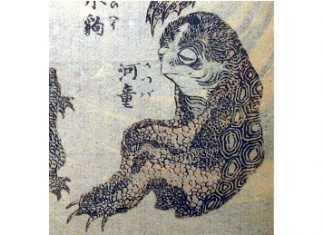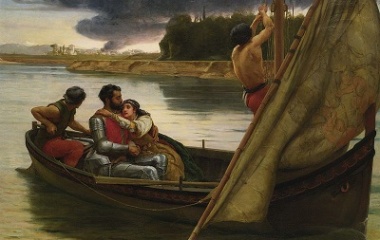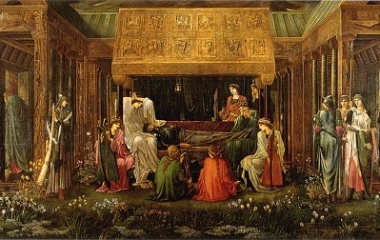Avalon is viewed as a mist-enshrouded island of ancient magic and myth, an entrance to the Otherworld where people lived for hundreds of years, and a modern source of inner peace and wisdom.
What Is Avalon?
Avalon is the mythical island, in Arthurian legend, also known as the Isle of Apples or Isle of Glass. The island’s legendary healing powers were said to restore King Arthur after he was injured in a major battle. His sword, Excalibur, was forged there too, according to Arthurian authors.
Source and Etymology
Avalon is first mentioned in Geoffrey of Monmouth’s Historia Regum Britanniae, a fictitious historical text written in 1136, where he refers to Avalon as Avallo. In his Vita Merlini, he refers to the Insula Pomorum, the Island of Apples, in connection with the mythical island. Here, we can see the close connection to the Celts, as the Celtic word Avallo, Old Irish aball, Middle Breton avallenn and Middle Welsh afall all refer to the apple. According to scholars, the apple likely represents immortality and also implies a far off place, due to the perception of apples generally being grown in far-away regions. The name Avalon may even be linked to Avalloc, a Celtic god, according to sources.
Location
In Celtic mythology, Avalon is associated with the afterlife and was even believed to exist outside of normal time. It was thought to be accessible by islands far off Britain’s coast. The Celts believed the islands were mystical gateways and referred to them as the Isles of the Dead. After Arthur was seriously wounded in the Battle of Camlann, he was taken to the island to heal. Sources claim the island was also the home of the Celtic goddess, Morgan le Fay. According to the Vita Merlini, Avalon was an island similar to the Fields of Elysium, where crops flourished and people lived extraordinarily long lives.
Glastonbury
Many Arthurian authors and historians consider Glastonbury as the location of Avalon. The name Glastonbury, in its earliest Welsh form, translated as the Isle of Glass. Since the area was very marshy, it was understandable that the people of the time considered it to be an island. In Celtic times, the Glastonbury Tor, or hill, was a sacred religious location. Pilgrims used to follow the priests and priestesses of the pagan, or old Celtic, religions in a procession up the Tor. They believed the Tor held a secret entrance to the afterlife.
From 670 AD, the Tor was occupied by a Benedictine monastery called Glastonbury Abbey. In 1190, the monks of the abbey claimed the bones of King Arthur and Guinevere were buried there. They purportedly discovered a cross and coffin on the grounds with the words Here lies renowned King Arthur in the Island of Avalon engraved on the cross. According to scholars, a large, male skeleton was found in the coffin, allegedly with a head wound. Unfortunately, the only proof of this claim is a second-hand account from a man who spoke to an alleged witness at the time. The monks’ claim did, however, draw a lot of attention to their abbey, which resulted in an influx of visitors and greater financial support. Even today, visitors are welcomed to Glastonbury with the sign: The Ancient Avalon. Historians continue to debate whether Glastonbury is in fact Avalon, but generally the claim is rejected.
In Modern References
The BBC’s Merlin television series is based on the Arthurian legends and mentions the mythical island. In the series, they refer frequently to the Lake of Avalon. The lake was home to immortal winged creatures called Sidhe and one of the few entrances to the afterlife. Merlin threw the sword, Excalibur, into the lake, where Arthur later retrieved it from the stone.
Many modern Pagans draw from the legend of Avalon as a path to inner wisdom. They also view the Glastonbury Tor as a significant spiritual location, even today. Lightworkers, spiritual healers, also believe the mystical island represents a path to inner peace or paradise.
Celtic polytheism has had a great influence on mythology, including the legend of Avalon. Since the Celts were closely tied with nature and the supernatural, the mythical island and its healing powers were a significant example of their belief system and, even today, the island remains bound to the healing and magical arts.










